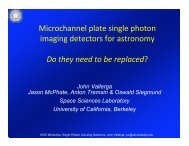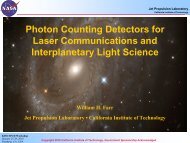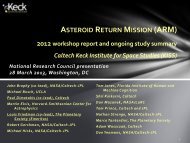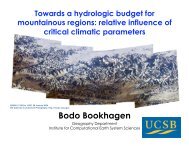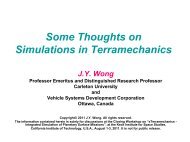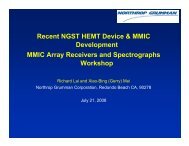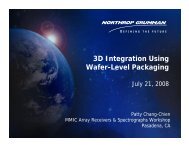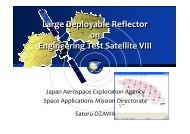Target NEO: Open Global Community NEO Workshop Report
Target NEO: Open Global Community NEO Workshop Report
Target NEO: Open Global Community NEO Workshop Report
Create successful ePaper yourself
Turn your PDF publications into a flip-book with our unique Google optimized e-Paper software.
DRAFT: RELEASED FOR PUBLIC COMMENTFigure 5: Astronaut Sunita L. Williams, ISS Expedition 14 Flight Engineer, Exerciseson the Treadmill Vibration Isolation System (TVIS) in the Zvezda Service ModuleThe logarithmic scales on both axes emphasize the growing volume requirements as mission durationis increased. However, it should be pointed out that these data represent vehicles that weresized primarily for engineering reasons, and not specifically for habitability. Proper and rigorousstandards for minimum acceptable volume are much more complex and must take into accountcrew size, mission length, expected tasks, how the volume is apportioned, etc. Such standards donot presently exist.For example, segmentation, privacy, and personal space are essential for long-duration missions.The ability to maintain sufficient sleep duration and proper sleep/wake cycles is one critical needthat is dependent on a successful habitability design. Aesthetics of the living environment and otherfactors (e.g., acoustic environment, odors, plants, etc.) are also essential aspects of habitabilitythat require careful consideration and innovative approaches in order to keep spacecraft masses atacceptable levels. Major improvements in the reliability, mass, and volume of life support systems(closed or nearly closed) are also enabling for future long-duration space missions. Figures 7 and 8show maintenance and repairs being performed on the ISS. These pictures highlight the sizeand reliability needs for deep space missions beyond LEO. Space will be at a premium for <strong>NEO</strong>missions. Figure 9 shows ISS Expedition 24 crew members in the ISS Tranquility Node, which hasapproximately two-thirds of the pressurized volume provided by the National Aeronautics and SpaceAdministration (NASA) deep space habitat designs currently being considered, and highlights thelevel of crowding that will be prevalent in small volumes when including the logistics needed forDRAFT: RELEASED FOR PUBLIC COMMENT 19




